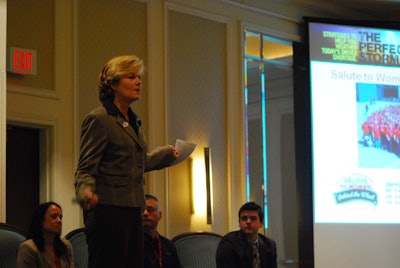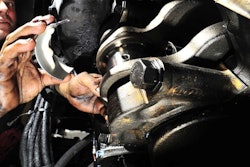 Ellen Voie, president and CEO of Women in Trucking, speaking at a Truckload Carriers Association conference in 2010.
Ellen Voie, president and CEO of Women in Trucking, speaking at a Truckload Carriers Association conference in 2010.Ellen Voie, president of the non-profit group Women in Trucking, says the number of pool of women drivers is growing steadily, and fleets should take that into consideration when spec’ing trucks, she told an audience at the Technology and Maintenance Council’s annual fall meeting in Pittsburgh this week.
Voie said in her address it’s important for component manufacturers and fleets to take women’s needs into consideration when designing and spec’ing new vehicles.
“When you make something that works for a large group of people, it still doesn’t work at well for a small group” and usually women are part of the latter, says Voie.
According to research presented by Voie at TMC, female drivers are on average six inches shorter and 50 pounds lighter than their male counterparts. That physical discrepancy can create some serious issues for female drivers operating trucks built and designed for men.
Voie says the most common complaint female drivers issue about their vehicles is in-cab design. Seats, pedals and gauges are all designed to maximize a male’s experience, says Voie. Female drivers typically have problems setting their seats for easy access to the pedals and maximum visibility of the gauges, with both sometimes being an issue.
Another issue Voie says women are constantly fighting is ease of access into their trucks. With first steps and hand rails placed in locations to benefit men, women are commonly forced to enter and exit their vehicles without much assistance.
For fleets employing a significant number of women, Voie advises listening to their recommendations and concerns when spec’ing new vehicles. She says manufacturers are starting to integrate female usage in their product designs, but says it will take a concerted effort from female drivers and fleet managers to maintain that integration.
“The number of women in the industry is growing,” she says.










